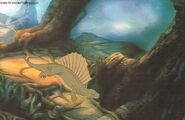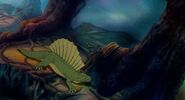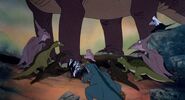Dimetrodon (pronounced /daɪˈmiːtrədɒn/; meaning "two measures of teeth" ) is an extinct genus of synapsid that lived in the Cisuralian (Early) Permian period. The name Dimetrodon refers to a range of animals under the genus, and it currently includes up to 20 subspecies in it, but the name is synonymous amongst them.
As a synapsid, it was more closely related to mammals than to true reptiles such as lizards and snakes. It is classified as a pelycosaur, which is an informal grouping composed of basal or primitive Late Paleozoic synapsids. Fossils of Dimetrodon have been found in North America and Europe.

Description and Paleobiology[]

Restoration of D. giganhomogenes with exposed neural spine tips
Skull[]
 |
 |
 |
 |
Dimetrodon was a carnivore and had two types of teeth in its mouth, like a mammal, shearing teeth and sharp canine teeth. Its name, in fact, means "two measures of teeth". This genus was one of the first with different-shaped teeth, and the teeth could for kill prey, then tear them to bits. It has a large skull with temporal holes at the back of each eye on the side, a unique trait of a synapsid skull. This made possible new attachment sites for jaw muscles, which could run fast and let the animal chew.[1][2]
In a 2001 study on the biomechanics of the dinosaur Albertosaurus's teeth, William L. Abler saw that examined Dimetrodon teeth had serrations so fine as to look like a crack in the tooth.[3] Though Albertosaurus had similar serrations, the base of each serration included a round void which would have functioned to distribute force over a larger surface area.[3] These voids would not let the "crack" formed by the serration to spread through the tooth.[3] Dimetrodon was found to lack adaptations to stop "crack" spreading.[3]
Legs[]
The strong legs of Dimetrodon were spread beside the body. Based on the construction of the legs, it was a fast and smoothly moving animal, especially compared to its solidly built, herbivorous relatives. The shape of the hip bones, the hind legs and the joints between the vertebrae can be seen.[4]
Sail[]

Two D. grandis skeletons, Royal Tyrrell Museum
Dimetrodon's most recognizable feature was a sail on its back, not unlike that of Spinosaurus. It is thought to have been used to regulate its body temperature. It would be able to pump blood into the sail and the sun would heat it. Then Dimetrodon's blood would go back into its body, warming the creature.
Species[]
The genus Dimetrodon currently includes several more or less recognized types:
| Species | Authority | Location | Status | Synonyms | Images |
|---|---|---|---|---|---|
| Dimetrodon angelensis | Olson, 1962 | Texas | Valid | 
| |
| Dimetrodon borealis | Leidy, 1854 | Prince Edward Island | Valid | Previously known as the dinosaur Bathygnathus borealis | 
|
| Dimetrodon booneorum | Romer, 1937 | Texas | Valid | ||
| Dimetrodon dollovianus | Case, 1907 | Texas | Valid | Embolophorus dollovianus Cope, 1888 | |
| Dimetrodon gigahomogenes | Case, 1907 | Texas | Valid | 
| |
| Dimetrodon grandis | Romer and Price, 1940 | Oklahoma Texas |
Valid | Clepsydrops gigas Cope, 1878 Dimetrodon gigas Cope, 1878 Theropleura grandis Case, 1907 Bathyglyptus theodori Case, 1911 Dimetrodon maximus Romer 1936 |

|
| Dimetrodon kempae | Romer, 1937 | Texas | Possible nomen dubium | ||
| Dimetrodon limbatus | Romer and Price, 1940 | Oklahoma Texas |
Valid | Clepsydrops limbatus Cope, 1877 Dimetrodon incisivus Cope, 1878 Dimetrodon rectiformis Cope, 1878 Dimetrodon semiradicatus Cope, 1881 |

|
| Dimetrodon loomisi | Romer, 1937 | Texas Oklahoma |
Valid | 
| |
| Dimetrodon macrospondylus | Case, 1907 | Texas | Valid | Clepsydrops macrospondylus Cope, 1884 Dimetrodon platycentrus Case, 1907 |
|
| Dimetrodon milleri | Romer, 1937 | Texas | Valid | 
| |
| Dimetrodon natalis | Romer, 1936 | Texas | Valid | Clepsydrops natalis Cope, 1878 | 
|
| Dimetrodon occidentalis | Berman, 1977 | Arizona New Mexico Utah |
Valid | ||
| Dimetrodon teutonis | Berman et al., 2001 | Germany | Valid |
Many species have been described by Edward Drinker Cope during his expeditions in 1880. Romer Alfred Sherman described a few species in the 1930s and 1940s. Most of the type specimens from the collection of which Cope based his descriptions were not released from the matrix. Reassessment after his death led to different conclusions on these specimens, including on the construction of the skull.[17] The status of some of the species described by Cope is questionable, namely D. fritillus, D. gigas, D. incisivus, D. rectiformis, and D. semiradicatus. There is a broad subdivision into species with a long skull from the Early Permian and species with a short head from the later parts of the Permian.
Paleoecology[]

Possible Dimetrodon footprint, Prehistoric Trackways National Monument
Fossils are known from the United States (Texas, Oklahoma, New Mexico, Arizona, Utah, and Ohio) and Germany, areas that the first parts of the Permian were part of the supercontinent Euramerica. Most fossil finds are part of lowland ecosystems, during the Permian would have been vast wetlands. In particular, the Red Beds of Texas is an area ofthe great diversity of fossils of Dimetrodon species and other species from the Early Permian. The fossils date from 290 to 270 million years ago, which means it lived from the Cisuralian to the Guadalupian period. Dimetrodon probably developed from a Sphenacodon-like ancestor. The climate of the Late Carboniferous (Pennsylvanaen) and Early Permian (Asse Lien, Sakmarien, Arti Skiing) resulted in warm, humid ecosystems in subtropical and tropical zones, consisting of vast wetland areas. In additio,n there were large ice sheets on the Southern Hemisphere that stretched to about 30° south. The fauna was concentrated in this period therefore in tropical and subtropical zones. Aquatic and semi-aquatic tetrapods dominated, while land predators as Dimetrodon were largely water-fed animals. The Early Permian had a drier and hotter climate where deserts began to develop. This led a climate change causing major extinction of the tetrapods, thus clearing the way for the development of therapsids. Dimetrodon was replaced as an apex predator by carnivores as Biarmosuchia and Dinocephalia.
Dimetrodon in The Land Before Time[]
Dimetrodon only appears in one entry in the Land Before Time franchise, and that is in the original 1988 film, Land Before Time. First, some Dimetrodon appear in a brief shot during the Great Earthshake, fleeing and being tossed by a wave of rock and debris. Later, an individual of a different species is seen while Littlefoot, Ducky, and Petrie are hiding in the "Big Underground", and as it passes them it flicks its tongue out (similarly to that of a snake or monitor lizard) and hisses.
There are two inaccuracies in this encounter and their appearance in the movie. One is that Dimetrodon did not live at the same time as the dinosaurs. It was not a dinosaur and it went extinct before the dinosaurs existed. However, many dinosaurs --and other prehistoric animals-- from different times and places --periods of time-- appear in the original film and the Land Before Time film series overall (which could excuse this). And two, is how the Dimetrodon (the one which passes the children) sticks its tongue out to taste the air like a snake or monitor lizard. Since it was a close relative to mammals and not reptiles (such as monitor lizards and snakes), it would not have done this.
Recent studies have shown that Dimetrodon's sail had the neural spines partially exposed at the tips, and that its walking gait was semi-erect like that of a crocodilian. However, these are more recent studies and such findings were not readily available when the film was in the pre-production stages.
it is one of the few Permian creatures to be in The Land Before Time
Gallery[]
References[]
- ↑ R & Demar Barghusen HR. (1972) "Mechanics and the Evolution of the synapsid jaw". Evolution, 26(4):622-637.
- ↑ HR Barghusen. (1973) "The adductor jaw musculature of Dimetrodon (Reptilia, Pelycosauria)". Journal of Paleontology, 47(5):823-834.
- ↑ 3.0 3.1 3.2 3.3 Alberto tooth abs 84
- ↑ The illustrated encyclopaedia of dinosaurs and prehistoric animals. D & B Palmer Cox. Second Edition; Könemann, 2000, p. 184.












